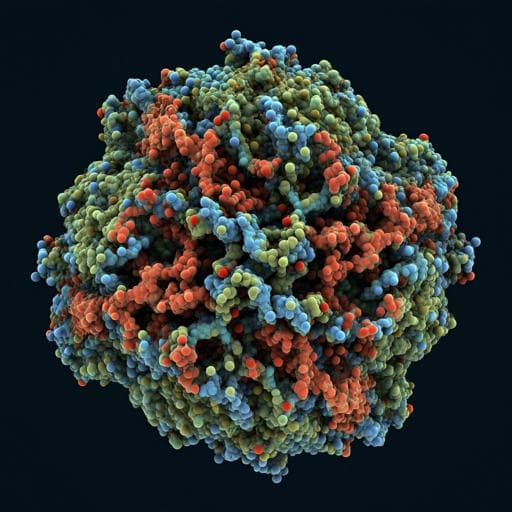
Biology
Atomic structure of a nudivirus occlusion body protein determined from a 70-year-old crystal sample
J. R. Keown, A. D. Crawshaw, et al.
Discover how researchers investigated the structure of a polyhedrin from the Nudiviridae virus family using X-ray crystallography. Led by Jeremy R. Keown and a team of experts, the study reveals the intricate stability and assembly principles behind this unique protein lattice, showcasing its resistance to environmental challenges.
~3 min • Beginner • English
Introduction
Viral occlusion bodies (OBs), or polyhedra, are stable protein crystals that encapsulate virions within infected cells and serve as an environmentally persistent infectious form for several insect virus families (Baculoviridae, Reoviridae/cypoviruses, Poxviridae). Historically identified by their reflective, polyhedral appearance and later shown to contain virions, OBs are primarily composed of a single 25–33 kDa polyhedrin that protects embedded virions from environmental insults (dehydration, freeze–thaw, high temperatures, proteases, chaotropes, acids, solvents) yet dissolves at alkaline pH (>10.5), facilitating infection in the alkaline midgut of insect larvae. Prior structural work has characterized native OBs from cypoviruses and baculoviruses and recombinant polyhedrin microcrystals produced in insect cells. Although polyhedrin sequences show little conservation and baculovirus versus cypovirus polyhedrins lack evident homology, their crystal lattices are strikingly similar (cubic I23 symmetry, unit cell 101–106 Å) and adopt predominantly β-strand folds with α-helical extensions, albeit with distinct topologies. Nudiviruses, a circular dsDNA family related to baculoviruses and of economic significance as pests/biocontrol agents, were originally thought to lack OBs, but OBs have been observed in nudiviruses infecting shrimp (PmNV) and marsh crane fly (ToNV), with putative polyhedrin genes identified yet showing little homology to baculovirus or cypovirus polyhedrins. The present study aims to determine whether structural features and lattice constraints of OBs are conserved in nudiviruses by solving the structure of the ToNV polyhedrin from native 70-year-old polyhedra and from recombinantly expressed protein.
Literature Review
Previous structural analyses of baculovirus and cypovirus polyhedra revealed cubic I23 lattices with unit cells of 101–106 Å and predominantly β-strand core folds with α-helical extensions, though without sequence homology between families. OBs have been long recognized as durable virion-encasing crystals and dissolve at alkaline pH, facilitating infection. Reports of OBs in nudivirus-infected cells (e.g., PmNV, ToNV) identified putative polyhedrin genes with little homology to baculovirus/cypovirus polyhedrins. Nudiviruses are ecologically and economically important, serving both as pests and biocontrol agents (e.g., OrNV). The role of tyrosine residues as potential alkaline pH sensors in polyhedra has been proposed. Prior attempts to determine structures relied on recombinant expression and crystallography or serial methods, and despite advances in protein structure prediction (AlphaFold, trRosetta), accurate MR-ready models for novel polyhedrins remain challenging.
Methodology
Samples: Native ToNV occlusion bodies (70-year-old archival crystals prepared in the 1950s) and recombinant ToNV polyhedrin crystals produced in Sf9 insect cells. The polyhedrin gene (ToNV ORF_059, YP_009116706.1) was synthesized and cloned into the Multibac system. Sf9 cells were infected and harvested at 72 h. Crystals were purified by repeated resuspension/sonication and 0.1% SDS washes until microscopically pure. For SeMet derivatization, mutations F104M/L105M/L137M were introduced; infected cells were shifted to methionine/cysteine-free medium, then supplemented with cysteine (150 mg/L) and selenomethionine (500 mg/L) before purification as above. Archival ToNV crystals required no further purification.
VMXm sample preparation and data collection: Crystal slurries were diluted to 50% (v/v) ethylene glycol and applied to glow-discharged Quantifoil R2/2 Cu 200 cryoEM grids using a Leica GP2 (20 °C, 90% humidity). Two microliters were applied to each grid side, blotted from the back for 7 s, and plunge-frozen in liquid ethane; grids were stored in LN2 and loaded into VMXm holders. Representative grids were imaged by cryo-SEM. Diffraction data were collected at Diamond Light Source VMXm on a DECTRIS EIGER2 X 9M CdTe with a 3.5 µm × 3 µm beam. For SeMet SAD: 0.9787 Å wavelength, 40° sweeps from 55 crystals (triage from 78), 0.02 s per 0.1° oscillation. For native (archival) data: 16 wedges (200 images each) from 65 crystals at 0.6328 Å, 0.2 s per 0.1° oscillation.
I24 beamline: Used to assess lattice stability and collect data on two observed unit cells in recombinant crystals. Approximately 100 nL crystal slurry was mounted on MiTeGen micromesh loops, excess wicked, then flash-cooled in LN2. Grid scans identified crystal positions. Data at 1.5498 Å targeted sulfur anomalous signal: 289 wedges of 16° sweeps (0.1°/frame, 0.02 s exposure) with a 7 µm × 7 µm beam on a PILATUS3 6M. Processing used DIALS and xia2.multiplex.
Phasing, model building, refinement: SeMet SAD phasing used CRANK v1.5 (3/4 Se sites found; initial FOM 0.158 improving to 0.349 after density modification). Automated model building yielded 212 residues (R/Rfree 22.3/29.1). Manual rebuilding in Coot and refinement in PHENIX followed. The SeMet model phased higher-resolution native (archival) data. Structural figures were prepared in PyMOL 2.4.1 and ChimeraX v1.4–1.6.
Structure prediction and MR trials: Molecular replacement attempts with existing polyhedra, trRosetta, AlphaFold (ColabFold v1.5), and oligomeric models failed. The sequence was submitted to CASP15 (Target-1122); a few models captured partial secondary structure placement but none enabled MR.
Stability assays: Recombinant crystals were subjected to multiple stresses, then assessed by diffraction (I24). Conditions included: 8 M urea (24 h), 10% w/v SDS (24 h), 1 M HCl (24 h), 20 mM NaH2CO3 pH 10.5 (3 or 24 h), 100% ethanol (3 or 24 h), 4 M NaCl (24 h), 1% v/v H2O2 (24 h), 10 mM DTT (24 h), 90 °C (3 h), and freeze–thaw. SDS-PAGE assessed disulfide reduction and pH effects: crystals incubated with NaH2CO3 pH 10.5 or water ±10 mM DTT; samples boiled 2 min and run on NuPAGE 4–12% BisTris gels.
Data deposition: PDB IDs 8BBT (archival sample), 8BC5 (SeMet), 8BCK (recombinant), 8BCL (recombinant expanded cell).
Key Findings
- Determined the atomic structure of the Tipula oleracea nudivirus (ToNV) polyhedrin from native 70-year-old occlusion bodies and recombinant crystals.
- Crystal form and contents: Space group P3221; unit cell a = b = 53.7 Å, c = 105.6 Å; one molecule per asymmetric unit; solvent content ~22% (Matthews coefficient 1.59 ų/Da), among the lowest in PDB structures.
- Fold: ~27.5 kDa, predominantly α-helical protein with 10 helices and a short two-stranded antiparallel β-sheet; residues 4–237 modeled with loop 171–174 disordered; N-terminal 38 residues (helices α1–α3 plus linker) form contacts with neighbors; unique 3D fold with no detectable structural homologs (FoldSeek, DALI, PDBeFold).
- Metal and unusual features: One Ca2+ bound between α5–α6 with pentagonal bipyramidal coordination; an uncommon cis peptide at Gly165–Ile166.
- Oligomeric building block: Symmetric dimer is the minimal repeating unit; dimer interface buries 1230 Ų per subunit, stabilized by hydrophobic and electrostatic interactions, including a salt bridge (Asp135–Arg211) and multiple hydrogen bonds; identified as the most stable interface by PISA.
- Lattice architecture: The lattice comprises stacked 2D sheets. Each protomer contacts 8 neighbors plus its dimer mate, forming 4 disulfide bonds, 34 H-bonds, and 30 salt bridges, burying ~48% (7518 Ų) of its surface within the 2D sheet. Inter-sheet contacts add ~44% buried surface and are reinforced by extensive N-terminal domain swapping (residues 1–38), with a largest single interface (domain swap) burying 1268 Ų.
- Disulfide network: Asymmetric disulfides Cys5–Cys167 (to protomer II) and Cys119–Cys179 (to protomer IV); Cys139 and Cys207 lie on crystallographic 2-fold axes with evidence of partial oxidation; disordered C-terminal Cys240/Cys241 likely form variable disulfides with neighboring Cys139/Cys207; the Cys5–Cys167 bond is absent in recombinant crystals, suggesting maturation or aging effects.
- Packing: Approximately 92% of each polyhedrin surface is buried within the assembled lattice; the crystal lacks continuous solvent channels and is highly interconnected via hydrophobic, electrostatic, disulfide, and domain-swapping interactions.
- Stability: Recombinant crystals resist many stresses and retain diffraction after 8 M urea (24 h), 100% ethanol (3–24 h), 4 M NaCl (24 h), 1% H2O2 (24 h), 10 mM DTT (24 h), 90 °C (3 h), and freeze–thaw. They dissolve in 10% w/v SDS (24 h) and 20 mM NaH2CO3 pH 10.5 (3–24 h). 1 M HCl (24 h) did not dissolve crystals but abolished diffraction.
- pH sensitivity mechanism: Tyrosine residues (~6% of sequence) cluster at inter-subunit interfaces, including in the N-terminal region and domain-swapping helices; their deprotonation near pH 10.1 likely destabilizes interfaces, promoting dissolution.
- Alternative crystal form: A minority (~10%) recombinant crystal population exhibited an expanded cell (a = b = 57.2 Å, c = 105.8 Å) with weaker diffraction (~2.8 Å) and disorder in residues 143–191, α1, and N-terminal α10, generating channels; reminiscent of a CPV4 polyhedra expanded form.
- Comparison to baculovirus/cypovirus: ToNV polyhedra differ in space group (trigonal P3221 vs cubic I23) and fold (predominantly α-helical vs β-rich), and use a dimeric repeating unit vs trimeric; nevertheless, all polyhedra share principles: mixed hydrophobic/electrostatic interfaces, N-terminal domain swapping, disulfide bonds (symmetric/asymmetric), and tyrosine-enriched interfaces for alkaline-triggered dissolution.
- Native vs recombinant: No lattice differences were observed between native (virion-containing) and recombinant crystals, indicating virion inclusion does not disrupt long-range lattice order.
- In silico modeling: AlphaFold/trRosetta and CASP15 models captured some secondary structure placement but were insufficient for molecular replacement, underscoring novelty of the fold.
Discussion
The ToNV polyhedra demonstrate that nudiviruses form occlusion bodies using a distinct protein fold and lattice symmetry from baculoviruses and cypoviruses, yet converge on common design principles for robustness and controlled dissolution. The lattice’s extreme packing density, extensive intermolecular interactions (hydrophobic, electrostatic, disulfide), and N-terminal domain swapping provide isotropic mechanical stability and environmental resistance while maintaining high symmetry to accommodate incorporation of elongated rod-shaped virions without long-range disruption. The abundance of interfacial tyrosines likely functions as an alkaline pH sensor, promoting lattice disassembly in the insect midgut, aligning with observed dissolution at pH ~10.5. The approximate 27.5 kDa size supports prior suggestions that polyhedrins below ~40 kDa are optimal for forming dense lattices that also accommodate virions. Despite the absence of structural conservation (space group, fold, unit cell), functional convergence is evident across viral families. The observed alternative expanded lattice state with local disorder suggests potential assembly/disassembly intermediates or purification artifacts. Differences between nudivirus and baculovirus OB architectures may reflect additional viral or host factors influencing assembly; elucidating packaging signals and virion incorporation mechanisms will be important future directions.
Conclusion
This study reports the atomic structure of a nudivirus occlusion body protein from a 70-year-old ToNV sample, revealing a unique, predominantly α-helical polyhedrin that assembles into a trigonal P3221 lattice via a symmetric dimeric unit. The lattice is exceptionally dense, stabilized by extensive hydrophobic and electrostatic interactions, multiple disulfide bonds, and N-terminal domain swapping, lacking continuous channels and resisting diverse environmental stresses while dissolving under alkaline conditions likely mediated by interfacial tyrosines. Although the ToNV polyhedrin fold and lattice symmetry differ from baculovirus and cypovirus polyhedra, all share core assembly principles, indicating convergent evolution toward robust, dissolvable virion-encasing crystals. Future research should define the molecular signals and auxiliary factors governing virion encapsidation in nudivirus OBs, characterize maturation-related disulfide formation, and probe environmental adaptations that modulate pH sensitivity across nudiviruses.
Limitations
- Stability experiments were performed on recombinant crystals; native occlusion bodies may exhibit different stability or dissolution behaviors.
- The Cys5–Cys167 disulfide is absent in recombinant crystals, potentially reflecting aging or maturation differences, expression host effects, or sample handling; precise maturation pathways remain unresolved.
- The alternative expanded lattice form observed in a subset of recombinant crystals has uncertain biological relevance (assembly/disassembly intermediate versus purification artifact).
- In silico models did not enable molecular replacement, highlighting limits of current prediction for novel folds and complicating phasing strategies.
- Some regions (loop 171–174, extreme termini) remain disordered and unmodeled, and the exact pattern of C-terminal disulfide linkages could not be uniquely assigned due to disorder and crystallographic symmetry.
Related Publications
Explore these studies to deepen your understanding of the subject.







